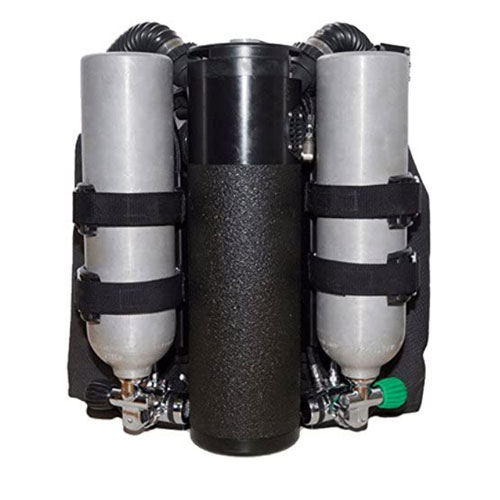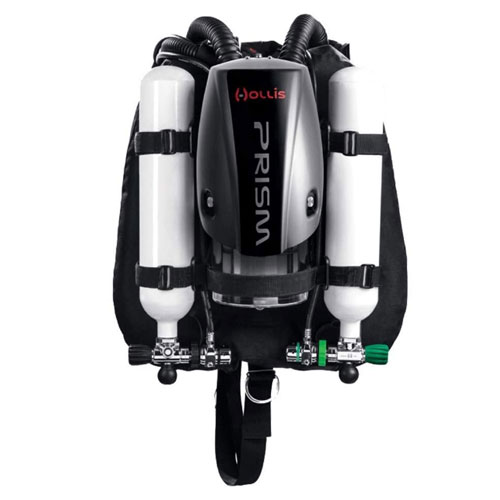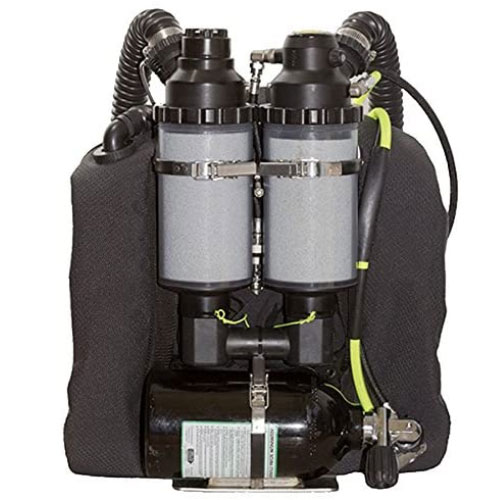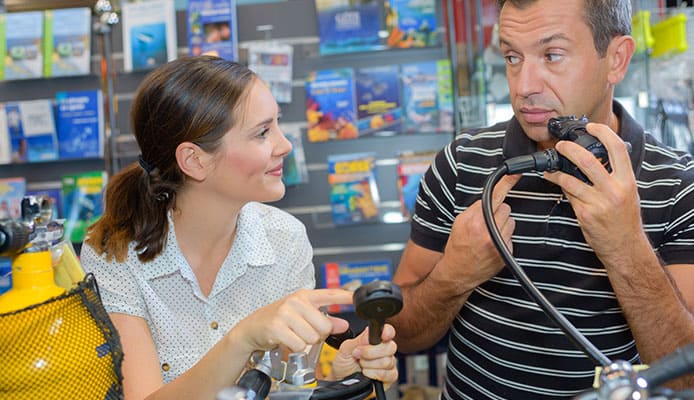
Your normal scuba diving setup is called an open circuit. The scuba tank holds air that has been compressed. We inhale taking a lungful of air from the tank, use it, and when we exhale it leaves the regulator and goes into the water. We then repeat the process. The air we breathe in as compressed air is mostly nitrogen (79%) and 21% oxygen, with trace amounts of other gases. Carbon dioxide is one of the other gases at about 0.004%. When we breathe we use some oxygen and the body produces carbon dioxide. When we exhale out, the oxygen level will be around 16% and carbon dioxide around 5%.
A rebreather is a closed-loop system. When we exhale, the air does not escape into the water but returns to the holding tank. A scrubber removes the carbon dioxide and oxygen is added to bring the concentration up to 21%. Instead of having to replace all the air as in an open circuit, we are only replacing the 5% that was used.
Because of the importance of their role in your dive, buying a rebreather should not be taken lightly. With this type of expensive equipment, you want to find the right design that suits your type of diving. To help you with this, our guide will give you all the information you need to find the best rebreather.
OUR TOP PICK
Kiss Classic Explorer mCCR
- Stand Out Features - Why We Love It
- Manual Closed Circuit Rebreather
- Axial flow scrubber is resistant to channeling
- No onboard electrical components
- Sensors for attaching a dive computer or PPO2 display
- Automatic diluent valve adds diluent gas
Depth rating: 300 feet (saltwater)
Scrubber Type: Axial
Scrubber capacity: 5.7 pounds (Sofnolime)
Max countering capacity: 8 liters (2 x 4 liters)
Dimensions: 21 x 14 x 8 inches
Weight: 51 pounds (fully packed)
EDITORS CHOICE
Hollis Prism 2
- Stand Out Features - Why We Love It
- Electronic Closed Circuit System
- 9V alkaline battery works up to 40 hours
- Easiest WOB (work of breathing)
- Three oxygen sensors for reliable control
- Counterlungs can be mounted front or back
Depth rating: 330 feet (saltwater)
Scrubber Type: Radial
Max counterlung capacity: 3.5 liters (front mount), 4 liters (back mount)
Dimensions: 21 x 17 x 9 inches
Weight: 47 pounds (fully packed)
BEST VALUE
Kiss Orca Spirit mCCR
- Stand Out Features - Why We Love It
- Bi-axial scrubber makes breathing easier
- Single oxygen cylinder onboard
- Off-board dilutant cylinder required
- Strong stainless steel frame
- Compatible with technical dive harnesses
Depth rating: 300 feet (saltwater)
Scrubber type: Bi-axial
Scrubber capacity: 6.2 pounds (Sofnolime)
Dimensions: 23 x 13.5 x 6 inches
Weight: 42 pounds (fully packed)
- Buying rebreather gear with a manufacturer warranty can reduce the cost of yearly maintenance. Some warranties even cover the shipping and handling fees to send in your equipment for servicing.
- Frequently, rebreathers are used for technical diving that requires near-perfect buoyancy and trims. By buying gear that has properly distributed features, you can avoid any complications down the road.
- After buying your equipment, read through the manual carefully. By reading about your equipment, you can properly prepare for minor field adjustments and repairs without having to send in your gear for servicing.
![]()
Scuba Diving Expert
How To Choose The Best Rebreather – Buying Guide
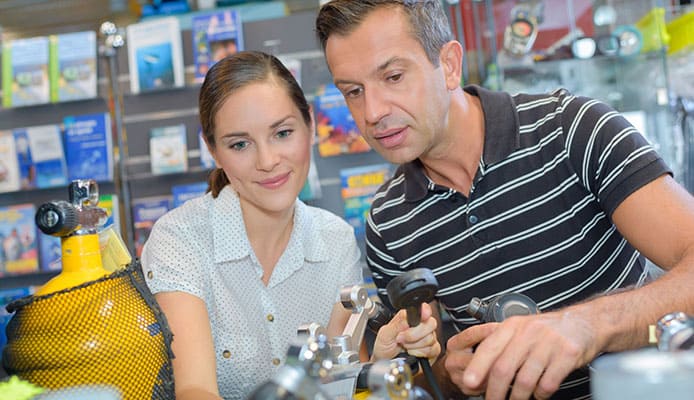
Type
Three different types of rebreathers exist. The differences between them are related to how the gas circuit is controlled and how fresh oxygen is reintroduced into the breathing loop. There are two types of closed-circuit rebreathers, as well as a semi-closed circuit design.
Electronic closed circuit rebreather (ECCR): eCCR rebreathers use a computer system to automatically monitor the amount of oxygen in your breathing loop, allowing them to constantly maintain the pO2 set point.
Manual Closed Circuit Rebreathers (MCCR): This type requires that you constantly check your levels of pO2 and manually add more oxygen into your breathing loop. Normally, these are less expensive, but require extensive knowledge on how the rebreathers work and how to adjust them.
Semi-closed Circuit Rebreathers: Semi-closed rebreathers will lose a small amount of gas with every breath you exhale. They will keep a relatively constant percentage of oxygen but can be problematic for decompression. This is why the semi-closed type is great as recreational rebreathers, but not the best choice for diving to greater depths.
Scrubber and Counter Lung Design
The scrubber canister is one of the most important components – it contains chemicals that extract the CO2 from your breathing loop. These come in different sizes and designs, which ultimately affects the canister’s duration. Take a brief look at some of the designs and the differences between them.
Axial: The scrubber pipe is cylindrical and allows the gas to pass in a vertical direction.
Radial: A radial-shaped scrubber allows the gas to pass radially from the center out. This type of canister lasts longer.
Counter lungs: These are bags located on the rebreather and are a part of the breathing loop. They can be placed on the back or shoulder–mounted. Back–mounted means the chest is free and exhaling is easier, but inhaling is harder. Shoulder-mounted bags are meant to be positioned as close to your lungs as possible. They will be easier to breathe with but can be cumbersome taking up chest space.
Quality
A rebreather takes oxygen and puts it into a loop; recycling old air into new, usable air that you breathe. This is why you must find the best rebreather with a top-notch design using the highest quality materials.
When it comes to an underwater rebreather, you’ll want to find the best quality you can. Brands like Kiss and Hollis have plenty of experience in making these devices, so you can count on a high standard in production resulting in reliable products. Before buying, you should take a training course on the model you wish to purchase. This will allow you to tell if it meets your requirements.
Annual Expenses
While the initial investment can be expensive, it doesn’t stop there. You’ll have to put more money annually to maintain your diving gear. The annual expenses can range from $300-$800 and will be spent on new cells, valves, and important servicing.
It’s extremely important for your diving safety that you don’t ignore the annual maintenance. Ignoring this can cause problems or malfunctions, which could lead to potentially dangerous situations.
Build and Breakdown Process
Build and breakdown depend on your specific rebreather and its design. Some models can be built in 10 minutes, while others require 45 minutes. The most important part is that you take the time you need to do it properly, whether you’re building or breaking down your rebreather. You do not want to rush this process.
The details of the process are important to get correct. Manufacturers always provide a detailed instruction manual on how you should set up your diving gear, so be sure to follow them. Keep in mind that, compared to regular open-circuit systems, rebreathers require a lot more work.
Basic Field Repairs
Small issues may pop up that don’t jeopardize your life but need fixing after a dive or before the next dive. Issues can stem from the cells, valves, or small leaks. You will have to determine, based on the design of your rebreather, if small field repairs are an option.
If you cannot fix your rebreather yourself, you have to get it serviced. This could mean that you lose a few weeks of diving with your suit, but all repairs must be done to ensure you have a safe dive.
You might also like: What Is A Drysuit, How Does It Work And When To Use It?
Size, Trim, and Weight Distribution
These factors are almost non-adjustable and cannot be altered. For this reason, you should pay close attention to the model specs before buying. You want your unit to fit you properly and not weigh you down too much. It should be comfortable to breathe with and trim out properly. Balanced weight makes your dive easier, so you want to avoid adding unnecessary weight to your rebreather.
FAQs
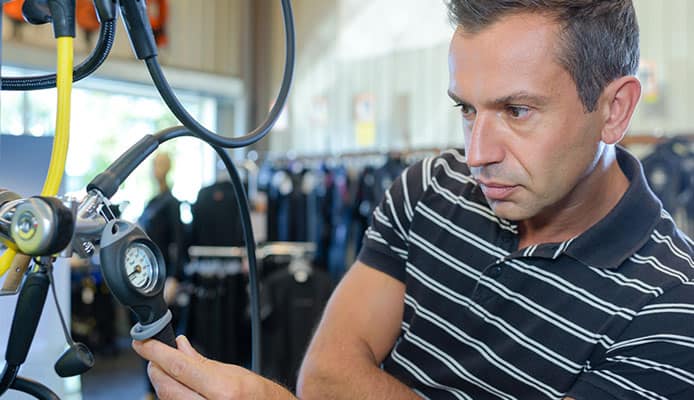
Q: How Do Rebreathers Work?
A scuba rebreather removes excessive CO2 from a breathing loop and adds the necessary amount of oxygen. This allows you to recycle your used air and turn it into new, breathable air. With a rebreather, you can spend more time underwater.
Q: How Long Can I Stay Underwater Using A Diving Rebreather?
Rebreathers for diving will allow you to stay under longer, but every underwater rebreather design is different. Most water rebreathers allow dives between 1-6 hours. If you focus on your breathing technique, the rebreather will extend your time underwater significantly.
Q: How Deep Can I Dive With A Rebreather?
How deep you can dive depends on a variety of factors. The main factors are the specific design of your rebreather and the water temperature where you are diving, along with some other variables.
Recreational rebreathers will normally work at depths of 40-130 feet. Most rebreathers will be certified for 300 feet. You should be certain you understand the limits of your rebreather and ensure that it will function for the type of dive you have planned.
Q: What Are The Risks Of Diving With A Rebreather?
The risks of diving with an underwater rebreather include hypoxia, receiving too little oxygen in the mixed air, or running out of oxygen entirely. Improper oxygen balance can be dangerous because it can lead to oxygen toxicity.
As with any dive, there can always be general malfunctions of the equipment or parts. To avoid any issues, the safest way to dive is to always use the buddy system and follow scuba diving safety tips. This way, you won’t be alone in case of an issue underwater.
Q: Can I Travel With It?
Yes, but it will ultimately be determined by your specific rebreather design. If you plan to travel the world, you will have to ensure that your rebreather can be checked as luggage or carried onto an airplane.
Q: How Much Training Do I Need Before Diving With A Rebreather?
You need to be an advanced diver preferably a technical diver. The extra dive times that a rebreather gives you mean you will need to know decompression theory. You need to understand how a rebreather works, no matter if you are interested in closed circuit rebreathers or a semi-closed circuit rebreather. If you have a Manual Closed Circuit Rebreather, you will need to be extra careful and understand how every part of your equipment functions.
Before buying, you should take a training course on the model you wish to purchase. This will allow you to tell if it meets your requirements. For example, Poseidon rebreather designs may differ from other rebreather designs, so you need to learn your specific rebreather model. You should always be fully trained in a rebreather before you dive in open water. You want to be prepared and trained for unexpected situations.
Q: Can You Get The Bends With A Rebreather?
Yes, you can. Like with open-circuit scuba, the gas you breathe is delivered at ambient pressure. At larger depths, the percentage of diluent is higher resulting in more inert gas in your system. This is why you always need to follow decompression steps, the same way you would do on an open circuit dive.
Q: Do Rebreathers Make Bubbles?
Very little or none at all. A semi-closed rebreather releases a small amount of gas with each breath and creates some bubbles. A closed-circuit rebreather doesn’t make any bubbles whatsoever. The absence of bubbles is great because you won’t disturb marine life and you can move without being noticed.
Q: Do Rebreathers Keep A Constant pO2?
Yes, usually. However, this depends on the type of device you have. A semi-closed rebreather will have the pO2 fluctuate somewhat, while a closed-circuit rebreather constantly monitors the O2 and precisely adds gas to keep the level steady throughout the dive.
Globo Surf Overview
For expert divers, learning new equipment can be a fun challenge. A top-rated rebreather for diving can be a great investment for divers who love to explore new techniques and want to extend their time underwater. Spending the time to find the best rebreather for diving will ensure you have a safe and fun dive trip, and we hope that our guide made the job easier for you.
More Scuba Reviews:
- BCD
- Dry Suit
- Scuba Fins For Travel
- Air Integrated Dive Computer
- Dive Bags
- Dive Boots
- Dive Compass
- Freediving Fins
- Freediving Watch
- Scuba Tank
Do you own one of the rebreathers that made it onto our list? Let us know how it has worked for your scuba diving needs in the comments section below.



